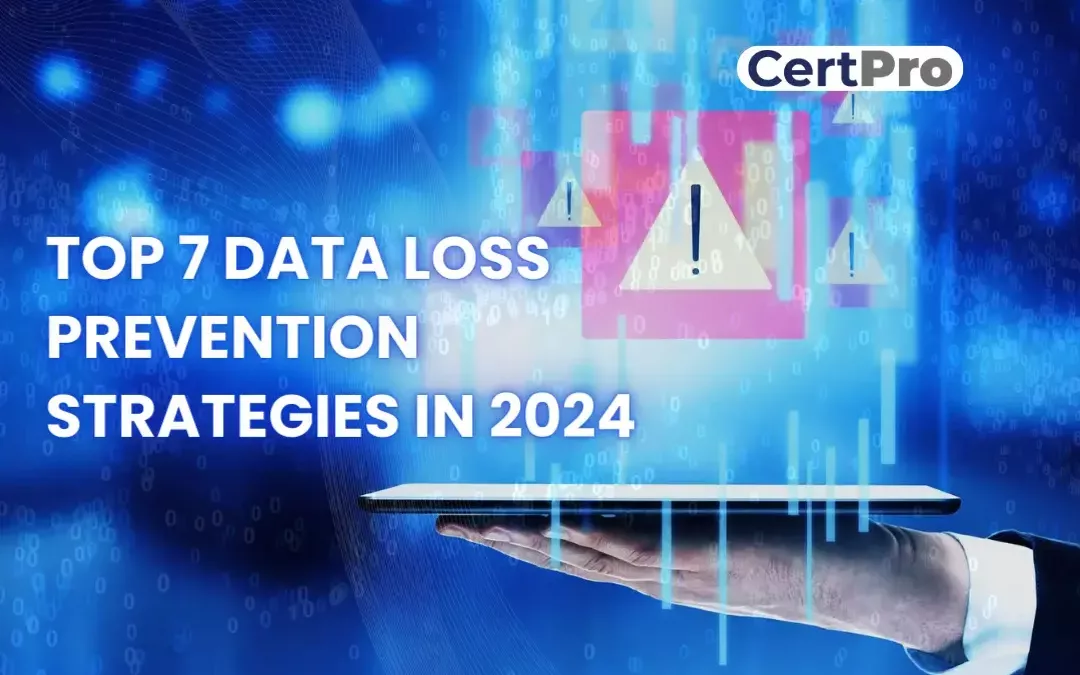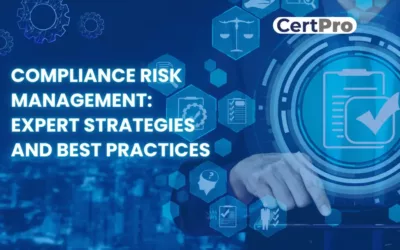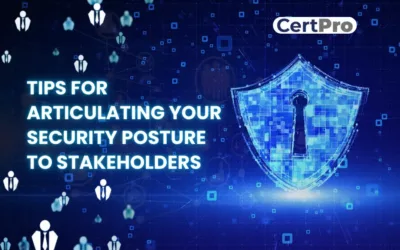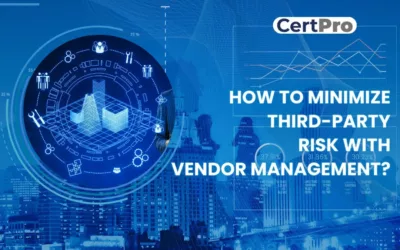In the contemporary business landscape, data is the cornerstone of organizational vitality. Businesses leverage data extensively to inform decisions, maintain competitiveness, and foster expansion. Nonetheless, they encounter multifaceted challenges emanating from internal and external spheres. These challenges encompass cyber threats, data breaches, and insider risks. Thus, it poses significant hazards to the integrity and confidentiality of data. Consequently, the imperative for robust Data Loss Prevention (DLP) measures becomes more important. Thus, companies can protect their data better by implementing effective strategies. This means keeping important information safe and ensuring they can handle changes in the digital world.
This article will mainly explore data loss prevention solutions. We’ll include how it works and its benefits. We’ll also discuss the causes of data leaks and the best seven prevention tips. Thus, understanding and implementing effective DLP measures is paramount in today’s digital landscape. It helps prevent risks and ensure constant business operations for your organization.
ABOUT DATA LOSS PREVENTION
Data Loss Prevention (DLP) is a method to protect sensitive information. It employs strategies to stop data breaches, leaks, or unauthorized access. Therefore, DLP closely monitors sensitive data in your organization’s digital setup. Consequently, it protects against loss, unauthorized access, corruption, or misuse. In addition, it safeguards customer data, financial records, organizational data, and employee files. Therefore, implementing DLP measures can enhance organizations’ data security posture. It prevents the risks associated with data loss or unauthorized exposure. DLP includes both technology tools and policy guidelines. It protects sensitive data and reduces the chances of data loss or leak.
Now, the question that may arise is: What is DLP software? DLP software protects sensitive data and meets HIPAA, PCI-DSS, and GDPR. Thus, it recognizes the violations of the rules and takes the necessary action. In addition, the DLP alerts the organization and uses encryption to stop data leaks. Furthermore, DLP tools monitor activities, filter network data, and defend data in the cloud. Additionally, Data Loss Prevention (DLP) software generates compliance reports. It also helps detect weaknesses and anomalies for forensic analysis and incident response.
KEY BENEFITS OF DLP SYSTEM
Data protection holds significant importance across legal, ethical, and operational domains. It is essential for organizations to implement data loss prevention for various reasons, including:
1. Enhanced Data Visibility: Cloud computing and big data have become more prevalent in this business environment, making it challenging to monitor confidential information. Again, cloud DLP solutions, in particular, provide companies with improved insights. It clearly shows how data is handled, stored, accessed, and utilized throughout the organization.
2. Security in Remote and BYOD Settings: DLP software can implement security rules and access restrictions for remote and BYOD employees, ensuring that security practices are consistent across different teams, departments, and locations.
3. Intellectual Property Protection: Businesses depend on trade secrets, proprietary processes, technologies, and competitive data. Thus, it paves the way for organizations to stay innovative and ahead of their competitors. Consequently, implementing a DLP strategy can safeguard these crucial assets.
4. Upholding Brand Reputation: Data breaches result in immediate financial losses and damage to customer trust, creating ongoing difficulties in managing a brand’s reputation. Thus, they highlight the critical need for proactive data protection measures.
5. Ensuring Regulatory Compliance: Data privacy laws such as GDPR, CCPA, and HIPAA require organizations to protect data well. Hence, not following these rules can result in hefty fines and legal problems. DLP solutions offer comprehensive reporting functionalities. This makes it easier to show that regulations are observed and reduces the risk of breaking them. In simple terms, preventing data loss reduces security risks and strengthens a company’s ability to handle challenges. Thus, it allows organizations to generate innovative ideas and protect the brand’s reputation.
CAUSES OF DATA LEAKAGE
Various factors contribute to data leakage, each presenting unique challenges to organizational cybersecurity:
1. Accidental Disclosures: Data leaks often occur due to the unintentional actions of trusted individuals who inadvertently expose sensitive information. Examples include mistakenly sending emails containing confidential data to the wrong recipients, misplacing corporate devices, or failing to secure devices with passwords or biometric protection.
2. Insider Threats: Malicious insiders, such as employees or trusted outsiders, may exploit their access to company systems. Therefore, it can perform for their gain or to collaborate with external attackers. The actions could include moving sensitive documents outside the organization when files are saved on unauthorized USB devices or stored in unauthorized cloud storage.
3. Software Configuration Errors: Misconfigurations can lead to significant data leaks, especially in cloud environments. They happen when giving too many permissions and not having proper database or cloud storage security. They expose credentials or encryption keys and make mistakes when connecting with third-party services.
4. Social Engineering Attacks: Hackers use social engineering tricks to breach company systems and access sensitive data. They can also mislead employees into sharing passwords or sending critical information to the hacker. Sometimes, they introduce malware into company systems to gain unauthorized access, which allows them to access the organization’s sensitive data.
5. Software Vulnerabilities: Outdated software or zero-day exploits pose a significant cybersecurity risk. Attackers can use these weaknesses to create various security threats, which might allow them to acquire crucial data without authorization.
6. Legacy Data: As companies expand and staff changes occur, they might lose track of old data. Subsequently, updating systems and changing infrastructure can accidentally reveal old data, which could be a security risk that attackers could use. Understanding the reasons why data leaks happen helps companies better protect sensitive information. They can then strengthen cybersecurity defenses to prevent unauthorized access and exposure.
TOP 7 STRATEGIES FOR IMPLEMENTING DLP
In this digital environment, the number of data breaches is increasing daily. Data leakage prevention is a critical aspect of modern cybersecurity. In this section, we’ll discuss seven different strategies for doing this. These strategies focus on managing risks in cybersecurity.
1. Discover Sensitive Data Locations: The first step in data leakage prevention is to find out where sensitive data is in a company’s digital setup. It means doing thorough searches to find where the data is stored. Therefore, it comes under spots like databases, file servers, cloud storage, and even personal devices. Hence, the data should be categorized based on its sensitivity and importance. Then, protect it with encryption, access control, and DLP solutions.
2. Evaluate Third-Party Risk: External vendors and partners sometimes need to use a company’s systems and data. It can be risky if not handled carefully. Furthermore, companies need to evaluate the risk from third parties. Therefore, examining their security practices and potential weaknesses leads to data leaks. Hence, questionnaires, testing, and ongoing checks can help lower these risks. It can ensure compliance with strict security rules.
3. Manage Privileged Credentials Securely: Privileged credentials, such as administrator accounts and API keys, provide elevated access within a company’s network. Therefore, safeguarding these credentials is vital to prevent unauthorized access and potential data leaks. Security best practices involve implementing Multi-Factor Authentication (MFA). Additionally, regularly rotating credentials, monitoring for suspicious activity, and using secure password management solutions can help store privileged credentials securely.
4. Strengthen Endpoint Security: Endpoints like desktops, laptops, mobile devices, and IoT gadgets are targets for cyber threats and data breaches. As remote work and mobile computing increase, securing endpoints is crucial. To do this, organizations should use endpoint protection. Always ensure device encryption and have strict endpoint security policies. Additionally, it regularly checks for vulnerabilities and manages patches.
5. Implement Robust Data Encryption: Encryption is essential for keeping data safe, whether stored or sent. Hence, organizations should use symmetric-key encryption to store and send data. They should also use public-key encryption for secure communication and authentication. Managing and controlling data access is important, as it can help keep encrypted data safe and private.
6. Regularly Review Access Permissions: Access control is crucial for preventing data leaks and stopping unauthorized access to sensitive data. Companies should periodically check and adjust who has access based on job roles. Using fingerprints, tokens, and strong passwords makes access more secure.
7. Educate Employees on Cybersecurity Awareness: Employees can be a significant problem in cybersecurity. Therefore, giving them good cybersecurity training helps them spot and report suspicious things. It allows them to get more information on following security rules and being safer with data. Regular training, fake phishing tests, and awareness campaigns can reduce the risk of data leaks because of mistakes.
Preventing data leaks requires a mix of technology, risk management, and teaching employees. By using these seven strategies, companies can significantly lower the risk of data breaches. These strategies keep sensitive information safe and adhere to data privacy and security rules in today’s digital world.
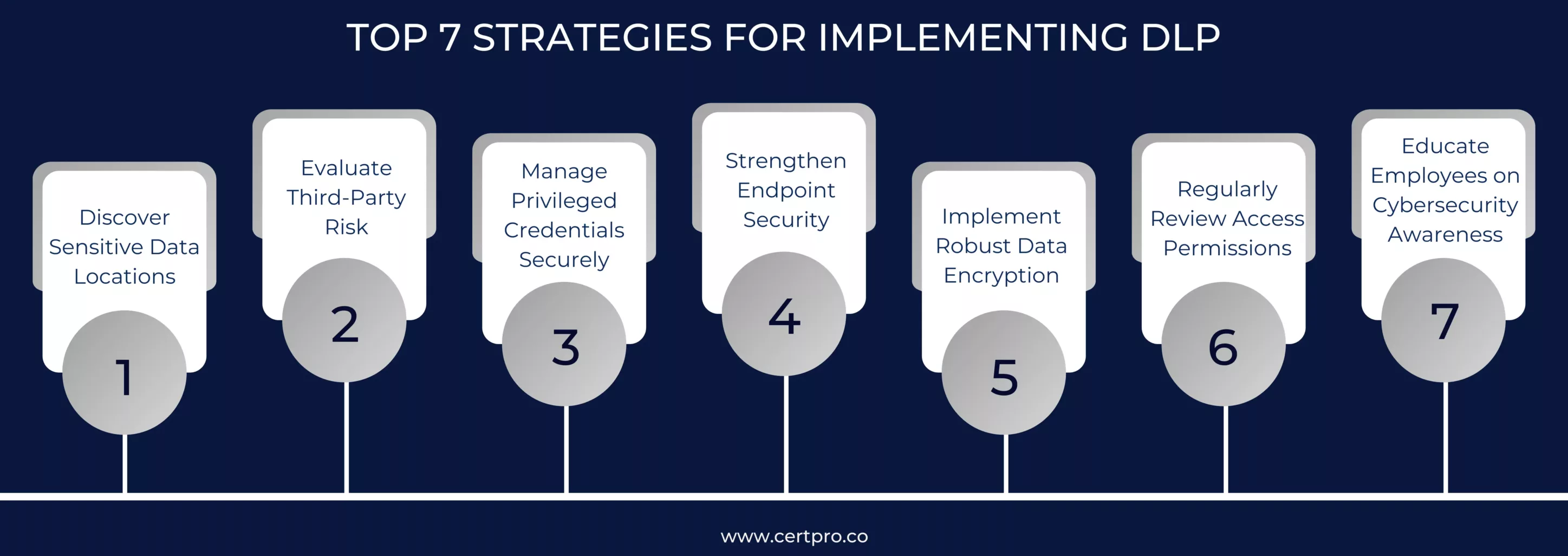
DLP STRATEGY TO STRENGTHEN DATA SECURITY
In 2024, cyber threats are worsening daily, even in this digital setup. Businesses need to have strong tools and policies to prevent data breaches. This involves finding important data and checking risks from other companies to keep credentials safe. It also makes devices secure, uses strong encryption, and checks access regularly. This also includes giving proper training to employees about cybersecurity. These actions strengthen defenses, lower data loss risks, follow rules, and keep trust. Early action keeps business running smoothly and boosts cybersecurity awareness. Having the proper cybersecurity tools is vital for a company’s safety. Thus, DLP helps any company, whether the threats are from inside or outside. Businesses, especially banks and healthcare companies, must keep sensitive data safe.
FAQ
What is a DLP policy?
A DLP or data security policy, is a set of rules that control how users handle data. It can limit access to data for risky individuals and teach employees safe ways to use and share data.
Is DLP a firewall?
No, Data Loss Prevention (DLP) is not a firewall. A firewall controls network traffic based on security rules. Thus, Data Loss Prevention (DLP) focuses on monitoring and blocking sensitive data to prevent unauthorized access and transmission outside the organization.
What are the types of data loss prevention (DLP)?
Mainly, there are three different types of data loss prevention (DLP), which are:
- Endpoint DLP: manages servers, computers, laptops, and mobile devices and keeps the data stored on them safe.
- Cloud DLP focuses on checking and encrypting sensitive data before it is stored in the cloud.
- Network DLP: It reviews network traffic to prevent the unauthorized sending of sensitive data. Its goal is to prevent data breaches by catching and blocking any attempts to send sensitive information without permission.
What are the main components of DLP?
Data Loss Prevention (DLP) has four key components: data discovery, policy management, endpoint protection, and network protection. Additionally, it encompasses securing data while stored, in transit, and during use.
Is DLP a host-based application?
Yes, DLP is host-based software. Thus, host-based DLP monitors the device data. Therefore, it offers greater insight into handling sensitive data and prevents unauthorized access to data.

About the Author
BHOOMIKA JOIS
Bhoomika Jois is a creative content writer specializing in compliance, ISO 27001, GDPR, and SOC 2. As a Social Media Marketing Specialist, she amplifies her engaging content. Bhoomika’s knack for simplifying complex topics makes compliance and cybersecurity accessible to all.
COMPLIANCE RISK MANAGEMENT: EXPERT STRATEGIES AND BEST PRACTICES
Compliance risk considers the organization's potential legal, material, and financial losses due to compliance failure. Thus, compliance risk is known as integrity risk. Organizations of all sizes are exposed to compliance risk. Hence, compliance failure results in...
TIPS FOR ARTICULATING YOUR SECURITY POSTURE TO STAKEHOLDERS
Cybersecurity is now a top-tier priority for any Organization. Data breaches can ruin the entire company, destroy customer trust, and damage reputation. However, companies can find decision-making difficulties because stakeholders, board members, department heads, and...
HOW TO MINIMIZE THIRD-PARTY RISK WITH VENDOR MANAGEMENT?
In today's interconnected business landscape, third-party vendors play an important role in accelerating growth and improving operational efficiency for enterprises across industries. However, increasing reliance on external partners entails an increased level of...

